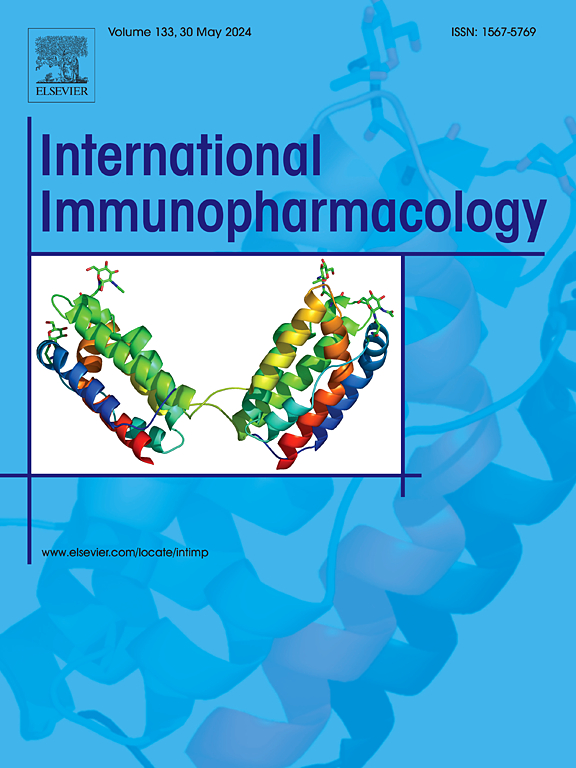山奈酚通过抑制TNFR1/JNK/p38信号通路减轻实验性自身免疫性神经炎。
IF 4.8
2区 医学
Q2 IMMUNOLOGY
引用次数: 0
摘要
山奈酚(Kae)是一种类黄酮,具有抗氧化、抗炎和神经保护作用。近年来,关于病毒感染引起的高致残率和致死率的格林-巴-本文章由计算机程序翻译,如有差异,请以英文原文为准。
Kaempferol attenuates experimental autoimmune neuritis through TNFR1/JNK/p38 signaling pathway inhibition
Kaempferol (Kae) is a flavonoid that has antioxidant, anti-inflammatory and neuroprotective effects. In recent years, there have been increasing reports on viral infection-induced Guillain-Barré syndrome (GBS) with high rates of disability and fatality. Therefore, in order to search for effective peripheral nerve injury repair drugs, we used rats with experimental autoimmune neuritis (EAN) as the typical animal model for GBS, and implemented Kae treatment intervention on EAN rats. Real-time quantitative polymerase chain reaction (qPCR), western blotting (WB) and immunofluorescence (IF) were utilized to detect the changes of inflammatory factors and signaling pathway proteins in peripheral nerve of rats. The impact of Kae on peripheral nerve damage in EAN rats was evaluated in multiple dimensions by clinical symptom score and neuroelectrophysiology examination, and the protective impact and mechanism of Kae on peripheral nerve injury were revealed. Our results showed that Kae increased the expression of sciatic myelin basic protein (MBP), decreased the expression of peripheral nerve macrophage infiltration and inflammatory cytokines, including TNF-α, IL-1β and IL-6, and down-regulated the expression levels of TNFR1. Additionally, it suppressed the activation of the JNK and p38 pathways. It can alleviate sciatic nerve symptoms and pathological injury in EAN rats. Therefore, we believe that Kae can be used as an adjunct drug in the treatment of GBS.
求助全文
通过发布文献求助,成功后即可免费获取论文全文。
去求助
来源期刊
CiteScore
8.40
自引率
3.60%
发文量
935
审稿时长
53 days
期刊介绍:
International Immunopharmacology is the primary vehicle for the publication of original research papers pertinent to the overlapping areas of immunology, pharmacology, cytokine biology, immunotherapy, immunopathology and immunotoxicology. Review articles that encompass these subjects are also welcome.
The subject material appropriate for submission includes:
• Clinical studies employing immunotherapy of any type including the use of: bacterial and chemical agents; thymic hormones, interferon, lymphokines, etc., in transplantation and diseases such as cancer, immunodeficiency, chronic infection and allergic, inflammatory or autoimmune disorders.
• Studies on the mechanisms of action of these agents for specific parameters of immune competence as well as the overall clinical state.
• Pre-clinical animal studies and in vitro studies on mechanisms of action with immunopotentiators, immunomodulators, immunoadjuvants and other pharmacological agents active on cells participating in immune or allergic responses.
• Pharmacological compounds, microbial products and toxicological agents that affect the lymphoid system, and their mechanisms of action.
• Agents that activate genes or modify transcription and translation within the immune response.
• Substances activated, generated, or released through immunologic or related pathways that are pharmacologically active.
• Production, function and regulation of cytokines and their receptors.
• Classical pharmacological studies on the effects of chemokines and bioactive factors released during immunological reactions.

 求助内容:
求助内容: 应助结果提醒方式:
应助结果提醒方式:


